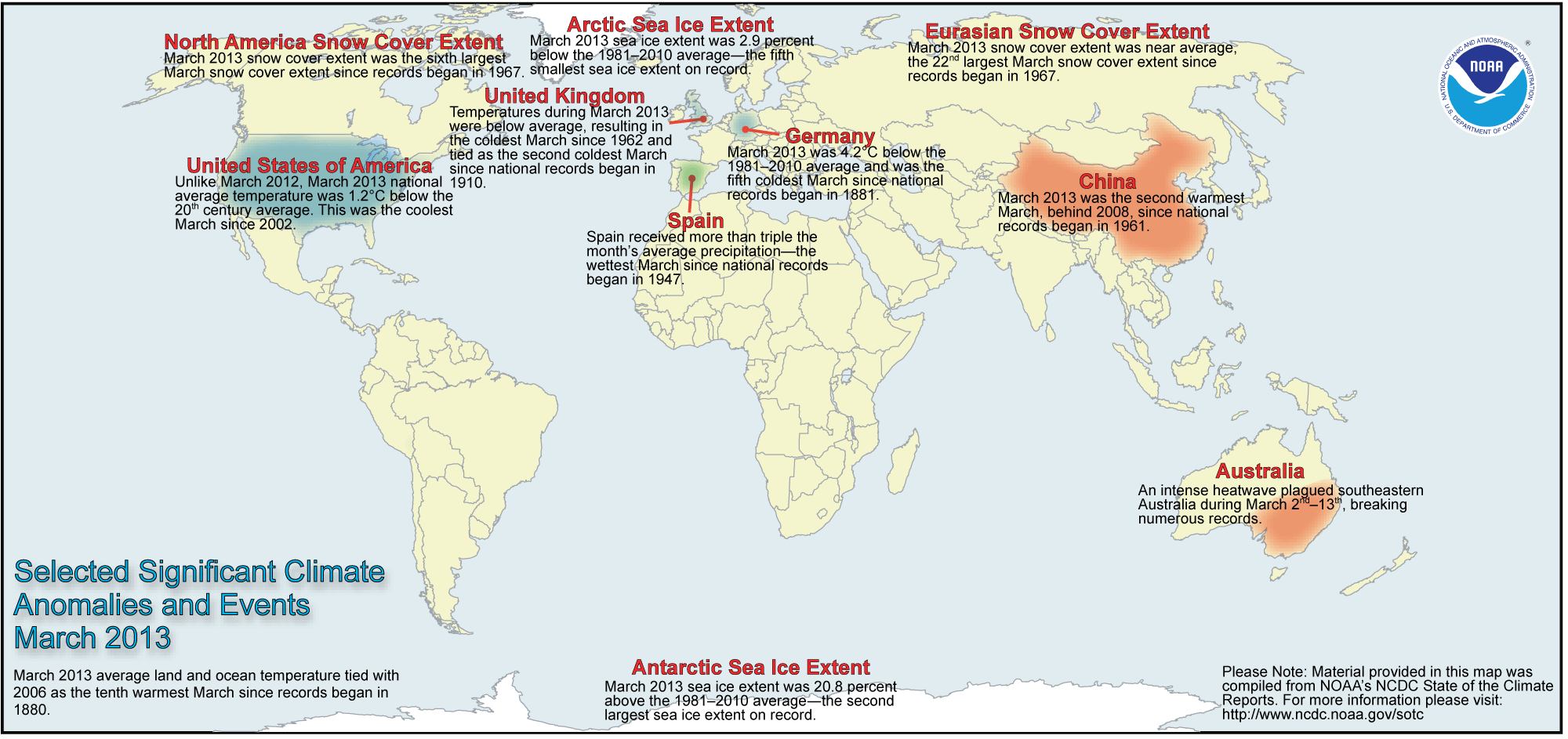Monthly Report Summary Information
The Monthly Report Summary Information is a synopsis of the collection of national and global summaries released each month.
Global Summary Information - March 2013
See Full Report
March 2013 global temperatures were 10th highest on record
Year-to-date eighth warmest period on record; Arctic ice reached its sixth smallest maximum extent on record.
The globally-averaged temperature for March 2013 tied with 2003 as the 10th warmest March since record keeping began in 1880. March 2013 also marks the 37th consecutive March and 337th consecutive month with a global temperature above the 20th century average.
Many areas of the world experienced higher-than-average monthly temperatures, including most of Africa and much of Asia. Far northeastern Canada, part of western Greenland, and sections of central Asia observed temperatures that were at least 9°F (5°C) above average. Meanwhile, most of Europe, northern Asia, central and western Canada, the central and eastern United States, and southern South America were notably cooler than average. Parts of northeastern Europe and western Russia observed temperatures that were at least 9°F (5°C) below average.
Global temperature highlights: March
- The combined average temperature over global land and ocean surfaces during March tied with 2006 as the 10th highest on record for March, at 55.94°F (13.28°C) or 1.04°F (0.58°C) above the 20th century average. The margin of error associated with this temperature is ±0.13°F (0.07°C).
- March marked the 37th consecutive March and 337th consecutive month with a global temperature above the 20th century average. The last below-average March temperature was March 1976 and the last below-average temperature for any month was February 1985.
- The global land temperature was the 11th warmest March on record, at 1.91°F (1.06°C) above the 20th century average of 40.8°F (5.0°C). The margin of error is ±0.23°F (0.13°C).
- Some national highlights are included below:
- The March nationally-averaged maximum temperature across Australia was 1.18°F (0.66°C) above the 1961–1990 average. This was the eighth consecutive month (since August 2012) that every state and territory across the country had an above-average monthly maximum temperature.
- China observed its second warmest March since records began in 1961. The provinces of Chongqing, Gansu, Guangxi, Guizhou, Hunan, Jiangxi, Ningxia, Qinghai, Shanxi, Shaanxi, Sichuan, Xinjiang, and Yunnan all reported record warmth for the month.
- The UK had its coolest March since 1962 and coolest month overall since December 2010, with the average temperature 5.9°F (3.3°C) below the 1981–2010 average.
- For the ocean, the March global sea surface temperature was 0.74°F (0.41°C), above the 20th century average of 60.7°F (15.9°C), the ninth warmest for March on record. The margin of error is ±0.07°F (0.04°C).
- Neither El Niñ'o nor La Niña conditions were present across the central and eastern equatorial Pacific Ocean during March, with sea surface temperatures slightly above average across the eastern half of the equatorial Pacific. According to NOAA's Climate Prediction Center, neutral conditions continue to be favored over the next few months.
Precipitation highlights: March
- As is typical, monthly precipitation varied greatly across the globe during March. In the Northern Hemisphere, several regions across central North America and Europe saw late-season snowstorms while other areas, such as northeastern Brazil and parts of New Zealand in the Southern Hemisphere continued to experience extreme dryness.
- The monthly precipitation total across Spain was more than three times higher than the 1971–2000 average March value, making this the wettest March since records began in 1947.
- Rainfall was more than 40 percent below average across most of New Zealand's North Island during March. With ongoing dry conditions, drought was declared for the entire North Island on March 15th.
Polar ice highlights: March and Seasonal
- According to data from the Rutgers Global Snow Lab, the Northern Hemisphere snow cover extent for March was the 16th largest in the 47-year period of record at 15.9 million square miles, which was 0.5 million square miles above the 1981–2010 average of 15.4 million square miles. Both the Eurasian and North American snow cover extents were above average during March.
- According to data from the National Snow and Ice Data Center, the average March Arctic sea ice extent was 5.81 million square miles, 170,000 square miles (2.9 percent) below the 1981–2010 average of 5.98 million square miles, resulting in the fifth smallest monthly March extent on record. On March 15th, Arctic sea ice reached its annual maximum extent, marking the end of the growth season and the beginning of the melt season. The annual maximum extent was 5.84 million square miles, the sixth smallest on record.
- The March Antarctic sea ice extent was 2.05 million square miles, 350,000 square miles (20.8 percent) above the 1981–2010 average of 1.70 million square miles. This marked the second largest March Antarctic sea ice extent on record, behind March 2008.
Global temperature highlights: Year-to-date
- The first quarter of 2013 tied was the eighth warmest such period on record, with a combined global land and ocean average surface temperature of 1.04°F (0.58°C) above the 20th century average of 54.1°F (12.3°C). The margin of error is ±0.18°F (0.10°C).
- The January–March worldwide land surface temperature was 1.85°F (1.03°C) above the 20th century average, making it the seventh warmest such period on record. The margin of error is ±0.40°F (0.22°C).
- The global ocean surface temperature for the year-to-date was 0.74°F (0.41°C) above average, making it the eighth warmest such period on record. The margin of error is ±0.07°F (0.04°C).
 NOAA's National Centers for Environmental Information
NOAA's National Centers for Environmental Information



